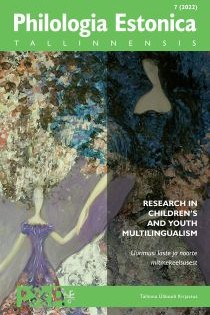Enabling tool: Estonian-English Code-Mixing of a 2-Year-Old with Balanced Input

Abstract
In recent years several studies have focused on bilingual children’s code-mixing in light of usage-based theory (Gaskins et al. 2019a; Quick et al. 2020; Yow et al. 2018). However, most studies on bilingual children so far have focused on families that employ the one-parent-onelanguage or minority language at home strategies, in which cases children often receive significantly more input in one language. The current case study focused on a 2-year-old (2;4–2;10) Estonian English bilingual whose language input was more balanced between her two languages. The results showed that the child’s balanced input was reflected in the output proportions of her two languages and in her mean length of utterance scores. The child produced many code-mixed utterances, which also had the highest mean length of utterance score and were more complex than monolingual utterances.
Keywords
bilingualism, code-mixing, MLU, usage-based, balanced input, Estonian, English